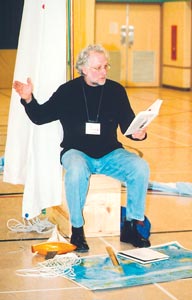PUPPETS IN THE DRAMA CLASSROOM: A collection of puppet-making and puppetry projects. GUIDED IMAGERY: Sensory awareness, imagination, story-making and concentration all are enhanced by this meditation-like activity. For around 3d grade to adult. Drama Notebook is a leading resource of royalty-free plays for schools. Perfect for drama teachers, classroom teachers, after-school professionals, theatre companies, and parent volunteers worldwide. Please take a moment to read about how the royalty-free script library works. (Grade-specific expectations for writing types are defined in standards 1–3 above.) W.7.6 Use technology, including the Internet, to produce and publish writing and link to and cite sources as well as to interact and collaborate with others, including linking to and citing sources. Created by Hossein Amini, James Watkins. With James Norton, Merab Ninidze, Kirill Pirogov, Igor Pokrajac. Alex Godman has spent his life trying to escape the shadow of their past.
Preparation/ Playing the Game / VariationsI didn't make this up, although I suspect I have made changes in it.I have used it for years, and I can't remember who gave it to me.
Within each group, each student chooses one thing that would be foundin the room. (For example, if the room is the kitchen, one student mightbe the refrigerator, one the stove, one the sink, etc.) Side-coach as necessary.After choosing an object, each student practices 'being' that object.
Each student must think of at least one--or with older kids, several--goodreasons that their object is important. Side-coach them to ask themselveswhat would happen if the thing were not there.
The teacher goes to the first group and exclaims, 'My, look at all thisuseless stuff! I've got to get rid of some of this junk!' (Or some such.)The teacher selects one student and says, 'I think I'll take THIS thingaway.'
The student replies, 'NO, YOU CAN'T TAKE ME!'
'Why not?'
The student answers, without mentioning the name of his object, in thisform: 'If you take me away. . .' followed by something that would go wrongwithout the object. (For example, if the student is pretending to be thebed, she might say, 'If you take me away, no one will get any sleep.' Astudent pretending to be a wastebasket might say, 'If you took me, therewould be trash all over the place.')*
Once all the students have had their say, the audience tries to guesswhat room they are in, and then what object each student is. Then the teachermoves on to the next group.
* With younger children, I usually stop at one answer. But with olderstudents, I don't give up so easily. I improvise some reason that the student'sfirst answer isn't compelling enough. 'Well, I never sleep anyway.' 'Ilike trash on the floor. I'm taking you anyway.' In this way I ask thestudents to think of more than one reason that something is important.If the students are sophisticated enough, I encourage them to think ofcreative answers. A student pretending to be the bed might say, 'What wouldthe kids jump on?' A student pretending to be a lawnmower once said, 'We'dget our feet wet walking through the yard.' He meant that the long grasswould hold water when it rained.
ImmigrantsVariation
My fourth-graders were studying immigrants and Ellis Island.I developed this variation of the game because they specially requestedthat we play this game (which they remember from playing it in the thirdgrade), and my special project this year is to tie my fourth-grade curriculuminto their Social Studies and Language Arts work. It is played in basicallythe same way, with the following changes:First I divide the class into three groups. One group becomes the 'oldcountry,' one the 'ship,' and one the 'new country'in our case New Yorkin the nineteenth century.
The students in the 'old country' group had to come up with somethingthat an immigrant might have to leave behindsomething that would be difficultto leave behind. (Cherished furniture, a pet or a friend, the silver, favoritetoys, etc.) The students in the 'ship' group become something (or someone,if you want) on board a ship that an immigrant might need on a long journey.(A bunk or hammock, the captain, the boat¹s engine, lifeboats, etc.) Thestudents in the 'new country' group become something a new immigrant wouldneed in his or her new land. (A grocery story, an apartment, an Englishbook, dollars, etc.)

When I approach the first group I say something like, 'Gee, I don¹thave room to pack all of this! I¹ll have to leave THIS behind!'
'No, you can¹t leave ME behind!'
With the second group I say, 'The ship is too full. I¹ll have to throwsomething overboard. I think I¹ll throw THIS overboard!'

'No, you can¹t throw ME overboard!'
With the third group I say, 'There¹s so many things in this new country.It¹s all so confusing. I think I¹ll get rid of some of it. I think I¹llthrow THIS away!'
'No, you can¹t throw ME away!'
My students seem to really understand and enjoy this variation.
Partsof the Body VariationInstead of a room in a house, the 'place' is the human body,and each student becomes a different body part. For example, onestudent might become a nose, another a lung, another a foot, and so on. (I have never had difficulty with students choosing 'inappropriate' bodyparts, but of course that's something to watch, and if you have a groupyou think is inclined that way, it is probably best to nip it in the budand specifically forbid 'inappropriate' responses.)Teacher says, 'Wow, this person's body is SO complicated! I don'tthink we need all these parts. I think I'm going to take THIS partaway.'
From here the game is played exactly as in the basic game. Studentsmust think of reasons that their particular body part is important. A nose: 'If you take me, you won't be able to smell the flowers!' A foot: 'Without me, you'd have to walk on your hands!' A heart: 'If you take me away, how will you get your blood to your body?' An ear might say, 'How could you hear anything?' but one once said to me,'If you take me away, your hat will fall down over your eyes and you won'tbe able to see!'
Usually this works best with the whole class at once, rather than brokeninto groups, but a more advanced class could be divided into groups accordingto kinds of body parts--one group could be internal organs, one bones,and one muscles, for example.
In its simple form this variation works even with pre-Kindergarten,yet is challenging enough for much older students.
RainforestVariationThis is explained in more detail in RainforestLessons,but the basic idea is that the 'room' is replaced witha rainforest, and students must become different plants or animals thatinhabit it, and explain why each is important to humankind. A conservationexercise.
 BookVariation
BookVariationEach group chooses a book, and then each person in the groupbecomes a character or an object that is important to the story. Then the instructor comes around with a giant (imaginary) eraser, and threatensto erase each in turn. Depending on the level of the students, youcan coach them to respond by explaining their character or object's importancein general, or, with a more advanced group, by explaining their characteror object's importance to the story. (For example, a studentrepresenting Charlotte in Charlotte's Web might talk about the importanceof spiders in the balance of nature, but a more advanced student mightinstead say something like, 'But if you erase me, who will teach the maincharacter self-confidence?' or 'Who will teach the reader about the circleof life?')GeneralTips and VariationsI have done this exercise with states or countries insteadof rooms. I have also done it with everyone AS a different state. (They had to come up with a reason that state is important to the wholecountry.)
Gr 7 (2)mac Drama Thora Sa Haq
I have done this exercise with time periods instead of rooms.
With Kindergarten I sometimes do it without the guessing. (Inother words, I simply 'guess' myself what each item is, rather than throwingit open to the class.) On the other hand, some Kindergarten classesdo quite well with the guessing.
With a small class, or a very young one, I don't divide the class intogroups, but conduct the game with the whole class as one group. Thisavoids the difficulties inherent in paying particular attention to onegroup while the other is left to its own devices.
Back to the top of lesson.What is a tableau?

Gr 7 (2)mac Drama Sub
In a tableau, participants make still images with their bodies to represent a scene. A tableau can be used to quickly establish a scene that involves a large number of characters. Because there is no movement, a tableau is easier to manage than a whole-group improvisation – yet can easily lead into extended drama activities. It can be used to explore a particular moment in a story or drama, or to replicate a photograph or artwork for deeper analysis.
How do you use tableaux?

Gr 7 (2)mac Drama Cool
Students stand in a circle, or around the performance area and a theme is given. One by one, they step into the space and establish freeze frames in relation to one another until the tableau is complete. At this point, thought tracking can be used to find out more about each of the characters. The scene can also be brought to life through improvisation, with the teacher clapping her hands to signal the beginning and end of the action.
Gr 7 (2)mac Dramatic
Once students are familiar with the technique, they can also work in small groups on different aspects of a theme. The class can discuss each group’s tableau in turn, mentioning what they can see happening, what they would like to know more about and what they think could happen next. Afterwards, each group can comment on how these viewpoints compared with their initial intentions.
Click below to watch a 14 minute TeachersTV video on tableaux, thought tracking and soundscapes for key stages 1 and 2.
Examples
- Pupils look at a painting or illustration of a historical scene that shows a selection of different characters. They bring it to life by representing the characters with their bodies.
- Current Affairs/History: Small groups are given different newspaper reports of the same incident (or differing accounts of an historical event) and asked to produce as accurate a tableau as possible. This can be used to examine how events may be communicated differently according to the observer’s point of view.
- For a more light-hearted activity, groups can devise a tableau on a specific theme, such as epic books or movies, famous locations or well-known historical events. The other students then try and guess what the tableau represents.